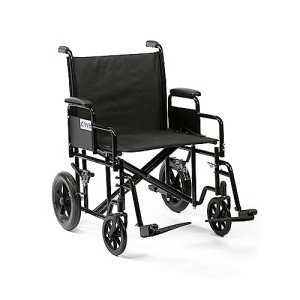The One Bariatric Wheelchair 24 Inch Seat Mistake That Every Beginning Bariatric Wheelchair 24 Inch Seat User Makes

Bariatric Wheelchair Seat Width
Seat Width
Having the right seat width is very important to wheelchair users who invest longer durations in their chairs. Too narrow a seat will cause pressure on the hips and thighs which might cause sores or pressure points. Having too large a seat can likewise make it hard for the user to reach the hand rims to propel themselves or maneuver in little spaces.
To determine the correct seat width a person would rest on a chair normally and have their measurement taken across their lap at the largest point which is typically their hips. A wheelchair measuring tape can be utilized to measure this, but a yard stick is preferred as it avoids individuals from covering the tape around their hips which would provide an incorrect outcome.
The standard wheelchair seat width is 16" (narrow grownup), 18" (basic adult), and 20" (large adult). For bariatric patients, a 24" seat is offered. This heavy-duty extra wide bariatric wheelchair from Medline includes swing-away footrests, a carbon steel frame with rust- and chip-resistant chrome plating, and easy-to-clean vinyl upholstery. It has a weight capacity of 500 pounds.
Seat Depth
Traditionally, the seat depth of a bariatric wheelchair was added 2" to the measurement taken at the user's best point (typically their hips). This was meant to accommodate additional layers of clothing that might be worn during winter. However, this practice is becoming less common as wheelchair users are able to invest more time indoors and are not wearing long coats. This makes the seat depth of a chair lesser when picking a bariatric wheelchair. Nevertheless, it is still crucial to select a choice that offers sufficient assistance for larger users.
Get the facts folding additional wide bariatric manual wheelchair features a comfy 24" seat width and a durable slide tube silver vein frame. It also has an adjustable axle and tool-free raising legrests.
Seat Height
When it pertains to determining the correct wheelchair seat width you must constantly measure from the user's largest point which is generally their hips. You will also require to think about whether the user is going to be wearing a winter season coat as this might include 2" to the width required.

When a wheelchair is in usage it should only be run on level surface areas with the wheel locks fully engaged. This is to prevent the chair from having the ability to move inclines that are 10 degrees or greater. It is likewise crucial to keep in mind that any activity that might shift the center of mass in the chair should be finished with care. This consists of grabbing items that need the individual to lean out of their seat or trying to stand from it.
Whenever you have the chair in use it is suggested that you regularly inspect it for damage and oil any locations that are considered needed. For example, the casters must be lubricated by removing the caster fork and utilizing a multi-purpose grease to use to the caster stem bearings. Likewise, the foot plates can be adjusted by loosening up the bolt and then moving them to the desired position. This allows the feet to sit easily on the footplate and avoids any pressure points from forming. This can be very uncomfortable for the user and if left ignored, can lead to push sores.
bariatric high back wheelchair are developed to support more weight than basic wheelchairs. This makes them sturdier and much better geared up to handle falls. They are likewise normally bigger and larger, making them less maneuverable in tight areas than basic wheelchairs. They need lorries with special ramps and lifts to fill them, in addition to drivers who understand how to finest transport them from one location to the next.
When selecting a wheelchair, consider its weight capacity as it will be the primary determining aspect in whether it will accommodate your traveler's needs. bariatric wheelchair 22 inch of the chair is often noted as a fixed load, implying that it suggests the quantity of weight the chair can conveniently hold while stalling. However, some producers also list an active load that is based on a drop test and can simulate the impact of someone taking a seat in the chair. This might be a more dependable measurement of the weight limit, depending on your needs.
If you prepare to carry out activities that shift your center of mass in the seat (such as grabbing things), be sure to have front casters pointed in a forward instructions and wheel locks engaged so the chair will not topple. Likewise, examine that casters are lubricated frequently to avoid excessive wear and abrasions. The lubrication procedure involves removing the fork, separating the caster from the wheel, and greasing the caster stem bearings with top quality multi-purpose grease.
